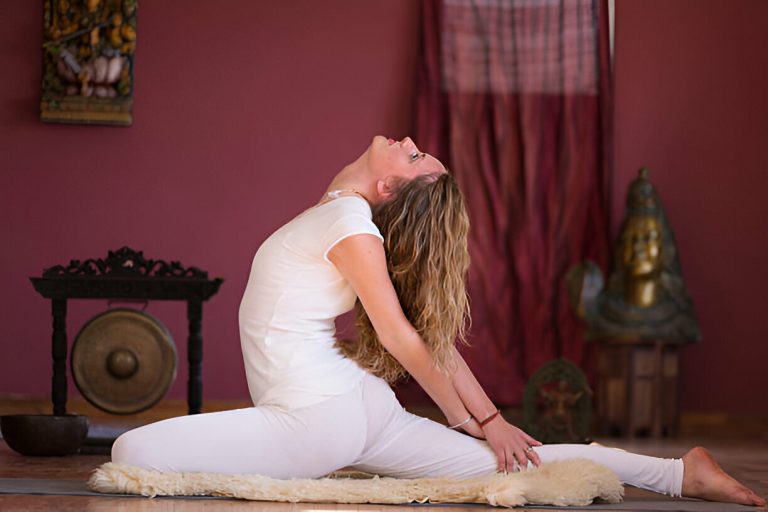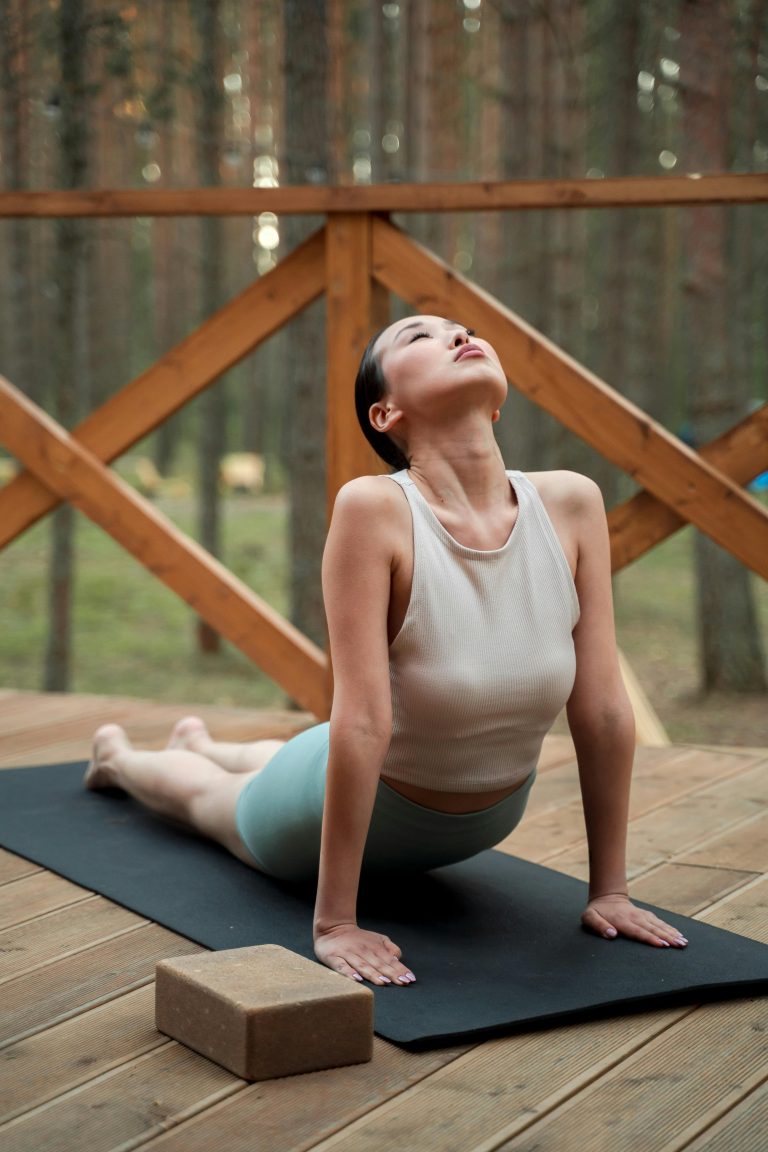Discover the Art of Alignment: Exploring the Benefits of Katonah Yoga

Katonah Yoga, developed by Nevine Michaan over the course of 40 years, is a blend of traditional Hatha yoga poses integrated with theories of geometry and metaphysics from Taoist and other ancient philosophies. At its core is the principle that the body is a template for asana practice, where poses facilitate the functionality and well-being of the organs, muscles, and joints. This practice employs the use of props, like straps and blocks, emphasizing the alignment of bones and the directionality of movement, alongside breathwork and meditation.
What distinguishes Katonah Yoga from other forms is the specific focus on the body’s alignment, not merely for aesthetic purposes but for its implications on health and personal growth. The practice is often seen as a way to map the body’s structure, discovering asymmetries and habitual patterns that can lead to imbalance or injury. By approaching yoga with an understanding of one’s unique body geometry, practitioners can adjust their poses to better support internal organs, improve circulation, and enhance the flow of energy throughout the body.
Delving into the intricate framework of Katonah Yoga reveals how it interweaves the wisdom of Chinese medicine, particularly the theory of meridians or energy pathways. The practice is thought to help harmonize the body’s chi, or life force, thereby contributing to improved emotional equilibrium and cognitive clarity. Moreover, the communal aspect of classes, where adjustments and insights are collectively shared, fosters a sense of interconnectedness and mutual support.
The upcoming discussion will consider the transformative potential of Katonah Yoga through personal testimonies and expert insights. It will highlight how the practice’s emphasis on proper alignment translates into daily life, shaping not only physical posture but also one’s approach to interpersonal relationships, work, and personal challenges. The text will delve into the ways this unique yoga variant can develop one’s understanding of spatial and personal boundaries, fostering a deeper connection with the self and the surrounding environment.
Katonah Yoga’s pedagogical approach incorporates the use of metaphor and imagery to enhance the learning experience, drawing parallels between the body’s structure and the architecture of a house. This method helps students envision the alignment process more vividly, reinforcing the value of a sturdy and well-maintained physical and mental framework. Lastly, the conversation on Katonah Yoga will continue to examine how its principles can be applied outside of the yoga studio, potentially influencing lifestyle choices and enhancing overall wellbeing.
- Katonah Yoga is a form of yoga unique for its integration of classical Hatha yoga with Taoist theory, geometry, magic, mythology, and metaphor to create a rich and holistic practice.
- This practice emphasizes personal well-being through self-awareness, proposing that mind and body alignment can be achieved through precise geometric positioning and understanding of body mechanics.
- One of the primary aims of Katonah Yoga is to increase practitioners’ functional capabilities by improving organ function, circulation, and the structure of the skeletal system.
- The use of props such as blocks, straps, and chairs is central to Katonah Yoga, helping to adjust the asanas to fit individual body shapes, sizes, and conditions, leading to a more personalized and effective practice.
- Teachings in Katonah Yoga also incorporate breathwork and meditation, fostering the development of a meditative mind, emotional stability, and the acquisition of life skills beyond physical asanas.
- Practitioners are encouraged to explore the metaphorical aspects of the practice, allowing them to attain a deeper understanding of themselves and their relationships to their surroundings.
- Katonah Yoga provides tools for self-reflection and self-care, allowing individuals to gauge their progress and challenges in both their yoga practice and daily life.
- Regular practice can lead to enhanced well-being as it harmonizes the internal body clocks, rhythms, and cycles, aligning the individual with the natural world.
- By focusing on the communal and therapeutic aspects of the practice, Katonah Yoga also fosters community building and the sharing of collective wisdom.
What is Katonah Yoga and How Can It Enhance Your Alignment?
Katonah Yoga is a modern merger of traditional Hatha yoga with Taoist theory, geometry, magic, mythology, and metaphor. It focuses significantly on the form and fitting of poses rather than the flow from one to the next. A pranayama practice in Katonah Yoga involves breath control exercises designed to enhance the flow of energy through the body. Alignment in this context refers to the precise way in which the body should be positioned in each yoga pose to maximize its effectiveness and minimize the risk of injury. Props, such as blocks and straps, are also often utilized in Katonah Yoga to aid in achieving and maintaining these alignments. Yoga poses, or asanas, are the specific positions that a practitioner holds to improve strength, flexibility, and balance.
The roots of Katonah Yoga lie in the synthesis of traditional yogic practice with other disciplines. It was developed by Nevine Michaan over the course of 40 years, drawing from her studies in Taoism, sacred geometry, and meditation. Grounded in the belief that the body is a repository of all life experiences, Katonah Yoga aims to map the body’s structure to its functions, seeing it as a microcosm of the universe’s macrocosm. Through this practice, one works to organize and orient their body symmetrically, striving for balance and stability in the three-dimensional form. By doing so, students of Katonah Yoga are thought to align their inner selves with the patterns of the natural world, promoting well-being and personal development.
Traditional Hatha Yoga: Achieving Physical and Mental Balance
Hatha Yoga is a traditional branch of yoga that combines physical postures (asanas), breathing techniques (pranayama), and meditation. It is designed to align and calm the body, mind, and spirit as preparation for meditation. This practice involves holding poses for long periods to master the posture as well as to focus the mind and regulate the breath. Each asana in Hatha Yoga is performed with particular attention to body alignment, encouraging a balance between strength and flexibility. By focusing closely on these elements, a deep awareness of the body is developed, and the practitioner can begin to notice subtle imbalances and correct them. Hatha Yoga classes typically end with a relaxation period, which can leave the individual feeling rejuvenated and refreshed, both mentally and physically.
Dynamic Vinyasa Flow: Cultivating Energy Through Movement
Vinyasa Flow is a dynamic and athletic form of yoga where practitioners synchronize movement with breath to flow from one pose to the next. The word ‘vinyasa’ can be translated to “arranging something in a special way,” and in this context, it refers to the precise way in which the poses run together in a smooth, dance-like sequence. Vinyasa classes often differ widely, with no two sessions being completely identical, as instructors have the freedom to incorporate their own sequences and pacing. This type of practice is known for its ability to build heat in the body, which can enhance flexibility and stamina. The continuous movement helps to elevate the heart rate, providing a cardiovascular benefit that’s not as present in more static yoga styles. Vinyasa yoga often features advanced breathing techniques and fast-paced transitions, resulting in an invigorating practice that focuses on the art of dynamic alignment through continuous motion.
Iyengar Yoga: Precision and Technique for Structural Alignment
Iyengar Yoga, founded by B.K.S. Iyengar, emphasizes precision and alignment in the posture and breath control. This meticulous practice pays close attention to the anatomical details and the alignment of each posture. It utilizes various props, such as blocks, straps, blankets, and bolsters, to help practitioners of all levels achieve the correct posture without risking injury. The use of these props makes Iyengar Yoga particularly beneficial for individuals with physical limitations or those who require a more therapeutic approach to their practice. Iyengar instructors undergo rigorous training and are known for their in-depth understanding of anatomy and the fine nuances of the body in yoga postures. Postures are typically held for a longer duration compared to other styles, which allows for deep, focused stretching and the opportunity to refine and perfect each pose for optimal alignment and therapeutic benefit.
Restorative Yoga: Gentle Approach for Stress Reduction
Restorative Yoga is a gentle and therapeutic style of yoga that aims to bring relaxation to both the body and the mind. This style typically involves a small number of postures that are held for extended periods, sometimes up to ten minutes per pose. The purpose of these long holds is to allow the body to completely relax into the support of props such as bolsters, blankets, and blocks, which makes this practice accessible to people of all fitness levels, including those recovering from injuries. Stress reduction is one of the main benefits of Restorative Yoga, as it activates the parasympathetic nervous system, reducing cortisol levels and promoting a sense of calm and well-being. It is known for its ability to realign the body and mind through passive stretching and meditative breathing, making it an ideal practice for those needing a respite from the busyness of modern life.
What is Katonah Yoga and how does it differ from other yoga styles?
Katonah Yoga is a unique blend of traditional hatha yoga postures, classical Taoist Chinese philosophy, and Western metaphysical concepts. It focuses on the alignment of the body, the breath, and the bones, using geometric principles to guide the practice. This approach is quite distinct from other styles of yoga in that it emphasizes the body’s structure and form as a tool for gaining insight and understanding personal patterns.
The practice incorporates the use of props, such as blocks, straps, and even chairs, to facilitate proper alignment and stability within the poses. The use of these aids helps practitioners adjust their postures to their body’s specific needs, making the practice accessible to a wider range of people. Katonah Yoga is as much a physical exercise as it is a method for self-exploration and personal growth.
Can beginners practice Katonah Yoga or is it for more experienced yogis?
Katonah Yoga is accessible to practitioners of all levels, including beginners. The use of props and the emphasis on alignment make it an excellent choice for those who are new to yoga or who have limitations that may make other styles challenging. Beginners can greatly benefit from the structured approach to postures, which helps to develop a solid foundation in yoga practice.
Teachers of Katonah Yoga are trained to provide modifications and adjustments tailored to individual students’ needs. Beginners are encouraged to start slowly and focus on the basic principles of alignment, gradually progressing as they become more comfortable with the poses and the unique theory behind the practice.
What are the main benefits of practicing Katonah Yoga?
Katonah Yoga offers numerous benefits, including improved physical alignment, increased flexibility, and greater strength. As practitioners work with their bodies’ geometry and proportions, they often experience enhanced stability and balance. This focus on the physical aspects of yoga also contributes to a deeper understanding of personal patterns and habits, both on and off the yoga mat.
Moreover, Katonah Yoga’s incorporation of breathwork and Taoist philosophy aids in the development of a calmer, more centered mental state. By marrying the breath with movement, individuals can cultivate a meditative practice that promotes mindfulness, reduces stress, and improves overall well-being. The practice encourages looking at the body as a house for the soul, thus promoting self-care, introspection, and emotional resilience.
How does Katonah Yoga address physical pain or injuries?
Katonah Yoga’s emphasis on alignment is particularly beneficial for individuals dealing with physical pain or injuries. By using props and adjusting postures to suit the needs of the body, practitioners can work in a way that avoids exacerbation of injuries and potentially aids in the healing process. The meticulous attention to the positioning of the body parts ensures that each pose is tailored to support and nurture rather than strain the body.
Furthermore, Katonah Yoga provides tools and techniques for practitioners to become more attuned to their body’s signals and to use their practice as a diagnostic tool. This awareness can lead to a deeper understanding of the sources of discomfort and contribute toward long-term pain management and injury prevention. Always consult with a healthcare provider before beginning any new exercise regimen, particularly if you are recovering from an injury or have chronic pain issues.
Is there a spiritual component to Katonah Yoga?
Yes, Katonah Yoga encompasses a spiritual element that is derived from its Taoist philosophy foundation. This aspect of the practice encourages exploration of the self through the physical body. The practice often involves meditative techniques and represents the body as a microcosm of the universe, reflecting Taoist beliefs about balance, harmony, and the interconnectivity of all things.
In addition to the physical alignment of poses, practitioners are invited to consider their place in the larger context of their community and the world, potentially leading to a more profound spiritual awareness and connection. While the spiritual component is present, individual practitioners may choose the extent to which they engage with these aspects based on personal beliefs and the guidance of their instructor.
Can Katonah Yoga help with stress or anxiety?
Katonah Yoga can be particularly effective in managing stress and anxiety. The practice’s focus on mindful movement, breathwork, and meditative principles tends to promote relaxation and reduce symptoms of stress. As practitioners engage in poses with the deliberate intention of harmonizing the body and mind, they often find a sense of calm and resilience that can be carried into their daily lives.
The structure of the practice also provides a sense of stability and grounding, which can be especially beneficial for those who experience anxiety. This stability, combined with the cognitive aspects of the practice that encourage reflection and self-awareness, helps individuals to develop coping skills that can alleviate stress and support emotional wellness over time.
What kind of commitment is needed to see benefits from Katonah Yoga?
As with most forms of yoga and exercise, the benefits of Katonah Yoga are most pronounced with regular practice. While an individual session can provide immediate feelings of relaxation and rejuvenation, long-term dedication to the practice is likely to yield more substantial results such as improved physical alignment, flexibility, and mental clarity. The frequency and duration of practice can be adapted to fit the individual’s schedule and goals.
Even a practice as short as 20-30 minutes, if done consistently, can offer significant improvements over time. However, given the philosophical depth of Katonah Yoga, those who choose to immerse themselves more deeply in the practice’s theory and principles will likely find an enriched experience that extends beyond the mat and into their daily lives.
What if I am not flexible? Can I still do Katonah Yoga?
Absolutely, flexibility is not a prerequisite for practicing Katonah Yoga. The practice is designed to accommodate people with varying levels of flexibility and mobility. One of the core principles of Katonah Yoga is individual alignment, meaning that each pose is adjusted to fit the practitioner’s body using props and modifications. The aim is to enhance body awareness and improve flexibility gradually, without forcing the body into positions that could lead to injury.
Instructors are trained to help students use props effectively to access the poses in a way that is productive for their unique body structure. Over time, regular practice of Katonah Yoga can naturally increase one’s flexibility in a safe and supportive way, all the while providing the many other physical and mental benefits of the practice.
Does Katonah Yoga require special equipment?
Katonah Yoga does make use of various props to assist in achieving proper alignment and to make poses more accessible. Common props include yoga blocks, straps, blankets, and sometimes chairs. However, most yoga studios that offer Katonah Yoga will have these props available for use during class. If practicing at home, investment in these props can help enhance the practice but are not mandatory. Improvised props such as books, belts, or towels can often be used as alternatives.
Having access to these props can significantly enrich the practice by providing stability and support, particularly for beginners or those with physical limitations. Investing in high-quality props that will last for years can be well worth it for those who commit to a regular practice, as they contribute to the safety and effectiveness of the exercises performed.
Where can I find a certified Katonah Yoga instructor?
Locating a certified Katonah Yoga instructor can be accomplished through various means. A good starting point is the official Katonah Yoga website, which may offer a directory of certified teachers or recommendations for searching. Additionally, exploring local yoga studios’ websites and inquiring about their yoga offerings often reveals whether they have certified Katonah Yoga instructors on staff.
Social media platforms and online forums devoted to yoga can also be resources for finding instructors in your area. As Katonah Yoga grows in popularity, more yoga practitioners are becoming certified, increasing the likelihood of finding a class nearby. Remember to look for instructors who have completed official certification to guarantee the highest quality and fidelity to the Katonah Yoga practice.
Final Thoughts
Katonah Yoga presents a framework for embodiment through its unique synthesis of classical yoga, Chinese medicine, and geometry. The practice’s focus on alignment goes beyond physical postures, aiming to align the body, mind, and spirit. By employing metaphorical concepts such as “fitting your body into the geometry of the poses,” Katonah Yoga encourages practitioners to explore the personal fit of their bodies within universal patterns, enhancing self-awareness and energetic optimization.
In the ideal practice of Katonah Yoga, students experience a transformation in their approach to yoga and well-being. It is this fabric of techniques, which interweaves breathwork, organ health, and the meridian system, that sets the practice apart, offering a holistic approach to self-care. The measurable progress in physical alignment is often mirrored by a newfound balance in other life facets, echoing the philosophy that personal well-being is reflected in one’s position in time and space.
Regular engagement with Katonah Yoga, as discussed, leads to numerous benefits ranging from improved joint stability, organ function, to augmented energy flow. These outcomes contribute to a more grounded, well-rounded practice, inviting a broader audience to experience yoga through a different, potentially more accessible lens.
Harnessing the insights from ancient teachings and modern understanding of the body, Katonah Yoga remains a potent modality for those seeking a comprehensive practice centered around alignment. Its contribution to the diverse tapestry of yoga underscores the importance of tradition and innovation in the journey towards personal health and self-discovery.






